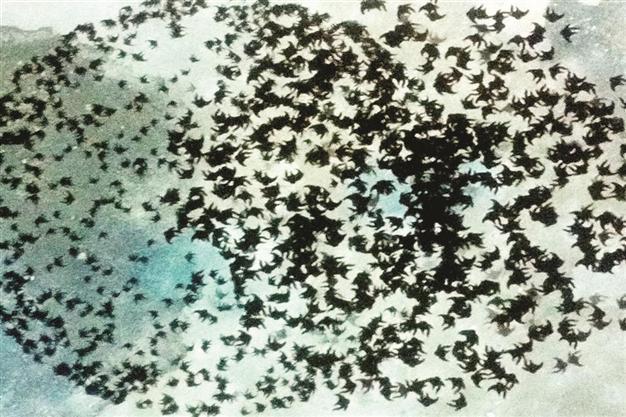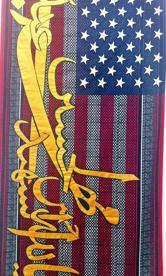Globalization questioned at Sharjah Biennal
SHARJAH - Hürriyet Daily News

The works at the Sharjah Biennial coincide with the cultural aspects of being a human in a cultural cartography.
The 11th edition of the Sharjah Biennial takes a very critical approach to how most people are living today. Curator Yuko Hasegawa has proposed a biennial that reassesses the Western-centrism of knowledge in modern times and reconsiders the relationship between the Arab world, Asia and the Far East, through North Africa and Latin America with the focus of “Re:emerge, Towards a New Cultural Cartography.”
The works at the biennial touch on the focus question and the topic delicately as they reveal how a new cultural cartography has been born and how it is perceived in different dimensions.
Sharjah’s architecture and historical background inspired Hasegawa as she decided the focus of the biennial.
She was inspired by the courtyard in Islamic architecture, in particular the historical courtyards of Sharjah, where elements of both public and private life intertwine, and where the objective political world and the introspective subjective space intersect and cross over.

The works at the biennial coincide most on the cultural aspects of being a human in a cultural cartography. The artists are encouraged to use Sharjah’s courtyards, streets, museums and cultural venues, which stand as important “cultural cartography” materials in the city.
For the 11th Sharjah Biennial, Hasegawa has selected more than 100 artists, architects, filmmakers, musicians and performers whose artworks and practices resonate with strands of the curatorial theme: the complexity and diversity of cultures and societies; spatial and political relations; notions of new forms of contact, dialogue and exchange; and production through art and architectural practices of new ways of knowing, thinking and feeling. With more than 35 new commissions, the biennial will unfold at sites across the city and will mark the inauguration of the Sharjah Art Foundation’s five new art spaces.
The works of each artist reflect a cultural part of their country or other countries. While the works are reflected as a plane of experience and experimentation, each of the artist’s works is like an arena for learning and critical thinking of a discursive and embodied kind.
The works reflect a network of intensifying international and globalizing links, and they are also revealed as an experiential and experimental aspect of the biennial.
Every part of Sharjah is used as a vital zone of creativity, transmission and transformation at the biennial.
On the other hand the cultural aspects that are reflected in the works play vital roles for the biennial’s focus.
The geographic and poetic approachGeography is a part of the biennial’s theme. For example Francis Alys’ work “Don’t Cross the Bridge Before You Get to the River,” which consists of videos, paintings, sculpture and installations, might be the best example to understand the theme of the biennial. Gibraltar is used as a significant area for his work. The fact that Gibraltar separates Africa from Europe seems like the fact that inspires Alys. The paintings and also the installations by Alys make the audience question how far the two continents are from each other and whether it is really possible for people to be separated by restrictions and nature. The fact that people can cross the country by sea also shows how it has become “impossible” for people to cross continents as Alys’ work makes the audience also question restrictions.
Gabriel Orozco’s work “Sand on Table as Model of ‘Self-Organizing Criticality,’” is an example of how the artist uses texts and diagrams to explain the theory of self-organizing criticality. Orozco used materials he found in Sharjah.
While the works reflect Sharjah’s materials and the notion of the usage of spaces in Sharjah, some works reflect a more global approach. Sara Rahbar’s War Series is mostly made with carpets and textile goods. Rahbar uses an American flag and guns on carpets as a reflection on war, and she names her works with the help of poetic language.
The poetic approach is not only found in the works’ names and titles; Shahzia Sikander’s 12-minute HD animation three-channel video work titled “Parrallax” is one of the best examples from Sharjah’s biennial.
Sikandar also touches on the cartography of Sharjah as she chooses to use the location of the city on the Strait of Hormuz and the area’s historical power tensions. Her video consists of drawings and paintings reflecting conflict and control and how those two notions make a human being’s existence.

 The works at the biennial coincide most on the cultural aspects of being a human in a cultural cartography. The artists are encouraged to use Sharjah’s courtyards, streets, museums and cultural venues, which stand as important “cultural cartography” materials in the city.
The works at the biennial coincide most on the cultural aspects of being a human in a cultural cartography. The artists are encouraged to use Sharjah’s courtyards, streets, museums and cultural venues, which stand as important “cultural cartography” materials in the city.